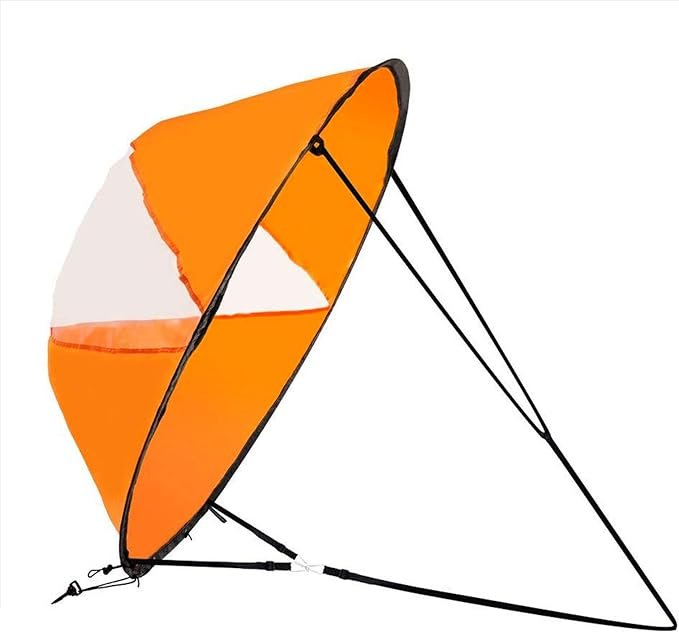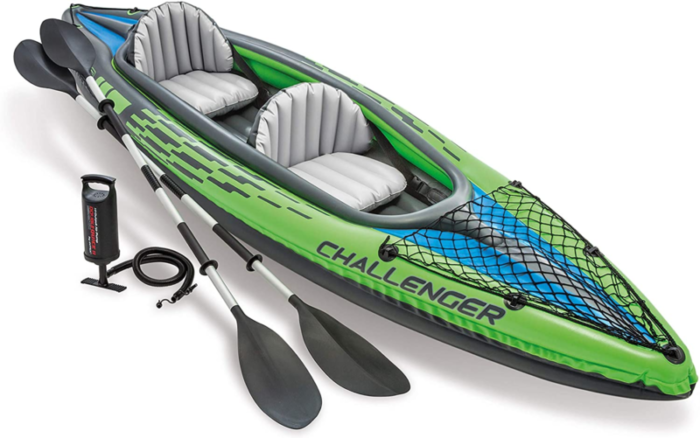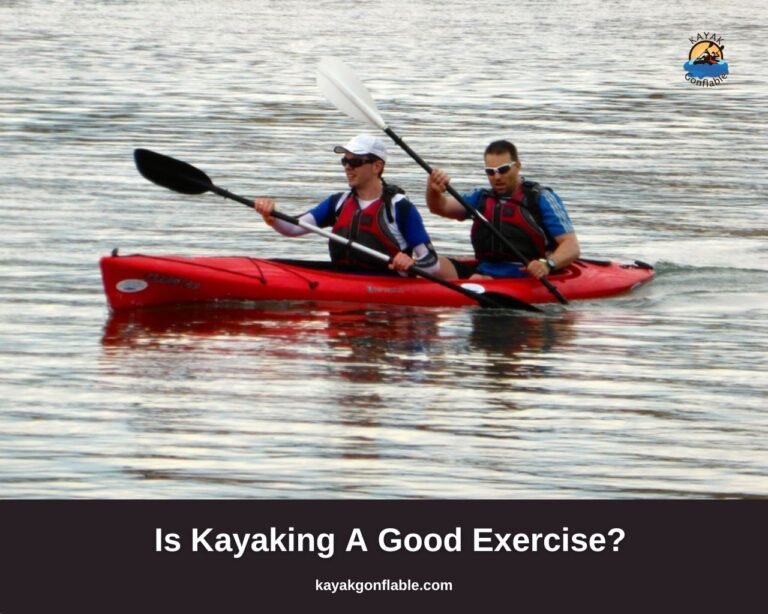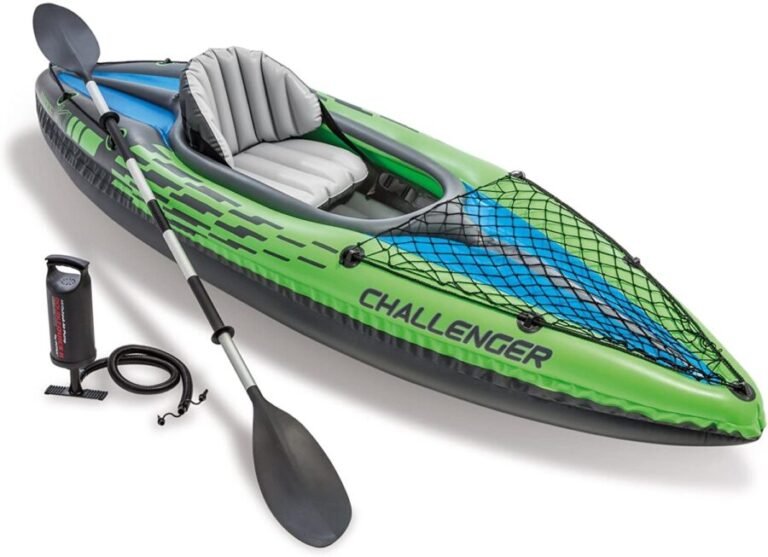How To Get Out Of A Kayak With Bad Knees

While kayaking is a fun paddle sport, like all things, it also has some tricky aspects, one of which is getting in and out of a kayak. These seemingly mundane endeavors are not the easiest things for even perfectly healthy kayakers to achieve.
So, if you have bad knees, it is a given that you will have a tough time entering and exiting your kayak.
Fortunately, several tips to make the ordeal bearable and make getting in and out of a kayak as painless as possible have been invented over the years, so you don’t have to give up your favorite sport just because your knees are not as strong as they used to be.
Today, we look into kayaking with bad knees and the tips you should hold dear to make your experience as comfortable as possible. Read on and remember, you don’t have to give up the joys of kayaking because of bad knees.
How To Get Out Of A Kayak With Bad Knees
After successfully getting into your kayak and paddling to your heart’s content, it is time to exit your kayak and face the rest of the day.
Knowing how to exit the kayak safely is very important if you have knee problems, as any wrong move could apply unnecessary pressure to your knees and put you in a world of pain.
Some exit methods to make life easier for you are explained below, so read on and pick the one that works best for you. Remember to practice the exit techniques in controlled conditions before picking one and having to perform it in real-time.
The Shallow Water Exit
As the name implies, this exit technique takes place in shallow water, so you are to refrain from letting the bow of the kayak reach the shoreline or bank.
The depth of the water should be between 6 to 12 inches, and you can measure that with your paddle (you can mark the required distance with a permanent marker or other substance beforehand).
Once everything checks out, swing your legs to either side of the kayak (it doesn’t matter which side), then turn your body until you are perpendicular to the kayak.
Next, you scoot to the edge of the kayak and can either use your paddle for support or drop it and push off the kayak to stand up. As you are already sitting in shallow water, standing up becomes easier, and you experience less strain.
The Swim Exit
As the name implies, this exit technique requires you to go for a swim, so you should only employ it on hot days or when you don’t mind getting wet. The technique takes place in shallow water that is about waist deep, that is about half your paddle length.
As the technique requires going for a swim, make sure your life jacket is properly fitted, and the water is clear of obstacles. You don’t want to injure yourself now.
Next, you are to roll your body out of the kayak and into the water. In other words, you flip the vessel over, then take a swim.
As you are in shallow water, you will easily be able to find the ground with your feet, and then you can stand up with considerably less strain on your legs. Once again, you could use your paddle for support if you so desire to make the standing-up process easier.
Rolling out of your kayak properly without injuring yourself requires adequate knowledge of the wet exit so be sure to brush up before attempting this technique. You can then push your kayak to shore.
The Help From A Friend Exit
If you go kayaking with a friend with better knees and don’t want to get wet, then this exit technique is for you. The method involves paddling with increased speed as you near the shore, such that a part of the hull rests on dry land.
Next, you drop your paddle and swing your legs onto either side of the kayak, such that you are perpendicular to the vessel. Now call your friend and wait patiently for his arrival.
Once your friend arrives, he should assume a stable position with his feet wide and his knees bent. You should then hold on to each other’s forearms and countdown together to synchronize your movements.
When you are both ready, your friend is to lift you up and not release you until you are sure you won’t lose your balance.
As most beaches and shorelines are slanted, there will be more strain on your downhill knee as you exit the kayak, so you want to make sure your good knee is the one that is downhill.
Say, for instance, that your right knee is worse than your left, you will want to exit the kayak from the left so your left knee experiences the most strain and vice versa.
The Crawl Out Exit
This method should be your last resort. Just like in the previous method, you gain momentum as you approach the shoreline, such that a part of the hull is on the shore, and you swing your legs to one side of the vessel.
Now, if you can manage it, you place your hands on the side of the hull and use them for support as you slowly rise to your feet. If your knee problem is not that severe, you should be able to manage it. But if the reverse is the case, then you will be crawling out of the kayak, as the technique’s name suggests.
Once you are sitting perpendicular to the kayak and your feet are on a side of the kayak, you roll yourself toward the shore such that your belly will be on your kayak in a similar position to that of someone who fell out of his kayak and just pulled himself back on.
Next, you gently back up on your hands and knees and crawl to a place where you can easily stand. While this method gives a show to those around you, it is undeniable that it gets the job done, especially if there is no familiar face around and you don’t want to ask for help.
That being said, you simply have to ask someone for help, and you won’t have to put on a show. While some medical conditions can hinder you from experiencing the joys of kayaking, aside from extreme cases, bad knees don’t make that list.
Making your ordeal as comfortable as possible, however, is up to you, so be sure to err on the side of caution. Employ safe kayaking practices and do not exceed your limits, and you will be fine.
How To Kayak With Bad Knees
If you’re an outdoorsy person with bad knees, you may think your days of kayaking are behind you. But never fear! There are ways to work around your knee pain and get back out on the water.
With a little bit of effort and creativity, you can find a way to kayak with bad knees. Below are some guidelines that you should follow if you have bad knees to make your ordeal easier.
Get Your Doctor’s Advice
Whether you are an avid kayaker who recently started feeling pain in your knees or you already have bad knees and hope to take up kayaking, you should first and foremost pay a visit to your doctor.
Your doctor would be able to tell you how damaged your knees are and the probable cause. He will also enlighten you on the dos and don’ts of your predicament so you can better take care of yourself.
If you are just starting to feel the pain, visit the doctor to avoid worsening your predicament. And if you intend to take up kayaking with bad knees, let your doctor instruct you on the best way to go about it.
Paddling is a strenuous activity, and getting the doctor’s okay can go a long way in putting your mind at ease and making sure you are in good health.
Choose The Right Kayak
Given that you already have bad knees, having an enjoyable kayaking experience can depend heavily on the type of kayak you choose.
While sit-in kayaks are great and protect you from the elements, their closed cockpit design is just not the best for you, so we recommend making use of a sit-on-top kayak.
If you are an avid kayaker who just developed knee problems, you can probably continue using a sit-in kayak; it’s just that the open cockpit design of sit-on-top kayaks will be more comfortable for you as you will have more freedom to move as you please, the kayak supports you, thus putting less strain on your knees; and most importantly, sit-on-top kayaks are easier to get in and out of.
Are Inflatable Kayaks A Good Choice For Someone With Bad Knees?
All things considered, inflatable kayaks appear to be a great choice for a kayaker with bad knees. They are very stable, can be easily transported and stored, and can be used in a wide range of water conditions.
The only flaw here is that unless they have a drop-snitched floor, they can be difficult to get in and out of, which is a major problem for people with bad knees.
The verdict thus depends on the gravity of your discomfort. Sit-on-top inflatable kayaks should give any kayaker with bad knees the best of both worlds, but if you are still worried about discomfort, you can always get an inflatable kayak with a drop-snitched floor.
Get The Right Equipment
This point cannot be overemphasized. To make the most of your kayaking experience and make it as comfortable as possible, you should get the right equipment, even if it means you have to spend more.
Get quality equipment, including the kayak, paddle, seat with a supportive backrest, knee pads, and other important equipment. Perhaps more important than procuring the right equipment is knowing how to use it.
Make sure you make the most of your equipment by using it correctly, and you will have an enjoyable paddling experience.
Do Stretching Exercise
Whether you believe it or not, stretching exercises help loosen your muscles, and that will make your paddling experience more enjoyable.
As the lower part of your body will be stationary for most of your paddling adventure, moving afterward can be quite difficult, especially for people with bad knees.
You will notice that stretching exercises help you warm up and make moving after paddling a lot easier. If it has been a while since you last went kayaking, be sure to stretch and warm up before hitting the water and things will be easier.
If you are kayaking often, cultivate the habit of stretching daily before and after your paddling adventure, and you will notice that your coordination will improve with time.
Get Coaching Or Training
This might not apply to you if you are an experienced kayaker who has bad knees, but if you are new to kayaking, getting private lessons from an experienced kayaker can do a lot to boost your confidence.
Many kayaking instructors have had to help people with disabilities enjoy kayaking, so they will have the experience and knowledge required to help you out.
The coach can help you pick the best equipment for you, and practicing your paddling techniques under an experienced eye is always a great way to improve your skills.
Choose Your Launching And Landing Spots With Care
Caution becomes your best friend if you are a kayaker with knee problems and one of the best ways to ensure you have a smooth trip is to pick your launching and landing spots wisely.
Ensure you always launch your kayak in shallow water, away from the boat traffic, to avoid getting hit by anyone. Make sure your launching point is not far from your vehicle, and if it is, be sure to use a kayak cart to make things as easy as possible for you.
Your launching point should also be easily accessible to others on the water so they can easily lend you a hand should you need help.
Elevate Your Legs While Paddling
Even people in perfect health experience stiffening of the muscles when they maintain a position for a long period of time and corresponding difficulty when they try to move, so those with bad knees can expect a worse ordeal.
When kayaking, you typically sit and leave your legs in place while paddling. The result is that blood can pool around your knees, and that makes for an unpleasant experience when you are ready to exit your kayak, particularly if you have bad knees.
Fortunately, you can spare yourself this ordeal by elevating your legs while paddling and preventing blood from pooling around your knees, or at the very least, reducing the amount of blood that pools around your knees.
You can elevate your legs by simply placing a drybag, backpack, or other soft item under your knees while paddling and you will be grateful for it when the time comes to exit your kayak.
Do Not Overexert Yourself
A great way to make sure all is well at the end of the day is to know your limits and not exceed them. This implies regulating the distance you kayak on every trip.
The longer the distance you paddle, the greater the tendency that you will end up with stiff knees at the end of the day, so be sure you know what you are doing.
If you are an avid kayaker who developed knee problems, you can start gauging your limits by kayaking half the distance you usually would and keep pushing the limits a little at a time so you will know the amount of time it is safe for you to spend on the water and stick to it.
If you are new to kayaking and have bad knees, we recommend kayaking with an experienced kayaker for a while so you can find out your limits in a controlled setting.
Part of not pushing yourself too hard is picking the waterbody you kayak in with care. This might be hard for some people, particularly experienced kayakers who are used to navigating whitewater rapids.
While you don’t have to give up your passion altogether, try being cautious while remembering that your knee problems mean you may not be able to successfully pull off some of the daring maneuvers you once could and act accordingly.
Kayaking can also be enjoyed on calm waters, and there is no use putting yourself unnecessarily at risk.
Do Not Hesitate To Ask For Help
Having bad knees sucks, especially when you begin to wrap your head around the fact that you will no longer be able to do several things as easily as you once did.
This can be overwhelming, particularly if you are kayaking in a place with no familiar face, and keeping to yourself regardless of what happens might seem like the safer option.
I’m telling you now that your pride is not worth your safety. It is very admirable that you did not let your knee problems come between you and your favorite sport.
So take that next step of courage and ask for aid whenever you need it. While all those you meet may not be quite friendly, you will surely find someone who will be glad to help.
Also, you did not let bad knees make you abandon kayaking, so why should you let pride get the better of you? Do yourself a favor and always ask for help when you need it.
How To Enter A Kayak With Bad Knees
How to safely get into a kayak is a skill all kayakers should master, particularly those with knee issues. This is because you won’t have to worry about getting out of a kayak if you are not able to get into one in the first place.
For those with knee problems to safely get into their watercraft and enjoy the sport they love, a step-by-step guideline for getting into a kayak is given below.
- Find an appropriate launch point in shallow water. The water should be knee-deep or half the length of your paddle.
- Position the kayak perpendicular to the bank or shoreline.
- Get to either side of the kayak and stand a few inches in front of the seat.
- Now throw one leg over your kayak so that you are straddling it with a foot on the ground on each side.
- Next, you are to keep the kayak in place to help maintain your balance. You can do this by yourself by holding onto the hull sides or better yet, you can get someone to hold the kayak down for you.
- Now, depending on which side of the kayak you are on, you can either lower yourself into the seat behind you or slide forward into the kayak seat.
- Next, you use your arms to lift your legs off the ground and set them into the kayak.
- You can now push yourself off the shore with your paddle and enjoy your adventure






